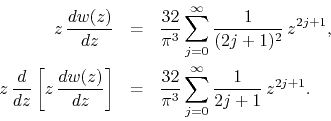Next: Bibliography Up: Appendix: Examples of Center Previous: Another Regular Cosine Series
Consider the Fourier series of a periodic function built with segments of quadratic functions, joined together so that the resulting function is continuous and differentiable. As is well known it is given by the sine series
![\begin{displaymath}
S_{\rm s}
=
\frac{32}{\pi^{3}}
\sum_{j=0}^{\infty}
\frac{1}{(2j+1)^{3}}\,
\sin[(2j+1)\theta].
\end{displaymath}](img333.png)
The corresponding FC series is then
![\begin{displaymath}
\bar{S}_{\rm s}
=
\frac{32}{\pi^{3}}
\sum_{j=0}^{\infty}
\frac{1}{(2j+1)^{3}}\,
\cos[(2j+1)\theta].
\end{displaymath}](img334.png)
Note that due to the factors of ![]() (with
(with ![]() ), these series
are already absolutely and uniformly convergent. But we will proceed with
the construction in any case. The complex
), these series
are already absolutely and uniformly convergent. But we will proceed with
the construction in any case. The complex ![]() series is given by
series is given by

and the complex power series ![]() is given by
is given by

The ratio test tells us that the disk of convergence of ![]() is the
unit disk. If we consider the inner analytic function
is the
unit disk. If we consider the inner analytic function ![]() within this
disk we observe that
within this
disk we observe that ![]() , as expected. We have for this function
, as expected. We have for this function

Being given by a monotonic series of step ![]() this function has two
dominant singularities, located at
this function has two
dominant singularities, located at ![]() and at
and at ![]() , as one can easily
verify by taking its second logarithmic derivative, which is proportional
to the inner analytic function of the standard square wave, that we
examined before in Subsection B.2,
, as one can easily
verify by taking its second logarithmic derivative, which is proportional
to the inner analytic function of the standard square wave, that we
examined before in Subsection B.2,

We must therefore use the two factors
![]() in the
construction of the center series,
in the
construction of the center series,
![\begin{eqnarray*}
C_{z}
& = &
\frac{32}{\pi^{3}}
\left(z^{2}-1\right)
\sum_...
... \frac{24j^{2}+2}{\left(4j^{2}-1\right)^{3}}\,
z^{2j}
\right].
\end{eqnarray*}](img339.png)
Unlike the original series, with coefficients that behave as ![]() (with
(with ![]() ), this series has coefficients that go to zero as
), this series has coefficients that go to zero as ![]() when
when ![]() , and therefore converges faster than the original one.
This shows, in particular, that our evaluation of the set of dominant
singularities of
, and therefore converges faster than the original one.
This shows, in particular, that our evaluation of the set of dominant
singularities of ![]() was in fact correct. We have therefore for
was in fact correct. We have therefore for ![]() the representation
the representation
![\begin{displaymath}
S_{z}
=
\frac{32}{\pi^{3}}\,
\frac{z}{z^{2}-1}
\left[
...
...frac{24j^{2}+2}{\left(4j^{2}-1\right)^{3}}\,
z^{2j}
\right],
\end{displaymath}](img341.png)
with the singularities factored out. Although both this series and the original one are absolutely and uniformly convergent, this converges faster, and may be differentiated twice, still resulting in other series that are also absolutely and uniformly convergent.
We may now take the real and imaginary parts of the ![]() series in
order to obtain faster-converging representation of the original DP
Fourier series and its FC series. We have on the unit circle, as we saw
before in Subsection B.2,
series in
order to obtain faster-converging representation of the original DP
Fourier series and its FC series. We have on the unit circle, as we saw
before in Subsection B.2,
and therefore
![\begin{eqnarray*}
S_{v}
& = &
\frac{16}{\pi^{3}}\,
\frac{-\mbox{\boldmath$\i...
...4j^{2}+2}{\left(4j^{2}-1\right)^{3}}\,
\cos(2j\theta)
\right].
\end{eqnarray*}](img342.png)
The original DP function is given by the imaginary part,
![\begin{displaymath}
f_{\rm s}(\theta)
=
\frac{16}{\pi^{3}\sin(\theta)}
\left...
...^{2}+2}{\left(4j^{2}-1\right)^{3}}\,
\cos(2j\theta)
\right],
\end{displaymath}](img343.png)
and the corresponding FC function
![]() is given by the real part,
is given by the real part,
![\begin{displaymath}
f_{\rm c}(\theta)
=
\frac{16}{\pi^{3}\sin(\theta)}
\left...
...^{2}+2}{\left(4j^{2}-1\right)^{3}}\,
\sin(2j\theta)
\right].
\end{displaymath}](img344.png)
Both of these series converge faster than the original Fourier series.